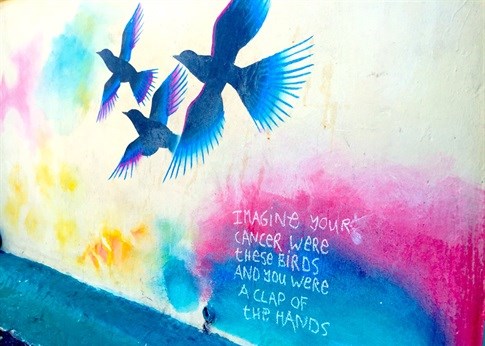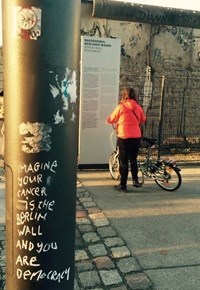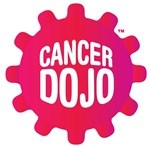Conn Bertish is known to some as the first South African ECD to take the leap from traditional to digital advertising. To me, he's the man who let me tap his brain through a hole in the back of his skull in a coffee shop...
Bertish is a cancer survivor. A Dunlop squash ball-sized tumour was removed from the back of his brain, with a similar 'pressure hole' drilled in the front - so when he's not wearing his standard porkpie hat, you notice there's something different about him. Adults are usually too polite to comment, but kids are great - they come up to him in shops, stare a while then point out there's a dent in his head. Bertish plays along by feigning surprise each time and feeling the back of his skull. But it was only through his own vigilance and sinking feeling that something was wrong that his cancer was discovered in the first place. He'd been having sharp headaches, which doctors pinned down to stress - after all, advertising is often quoted as one of the most stressful careers. But it was more than that. He started tripping over nothing. Slurring a few words. Feeling uneasy in his own skin, it was while taking down a phone message for his wife that the blinkers truly came off - no matter how hard he concentrated, he simply could not form the number '8' - it kept coming out as a '9' on the page. Terrified, the father of two insisted on further tests, and was booked in for emergency surgery the next day.
Bringing cancer to life, to better understand the journey
But it's not the fact that Bertish went through the surgery with ease that makes his story stand out - it's how he 'prepped his brain' for the process that's got people taking note. Bertish decided to imagine his brain as most flexible thing, bouncy like Magic Putty, to minimise his fears and enhance the chance of complete healing. The reason? "True creativity is about being agile, being able to work with what happens, when it happens," Bertish explains. He even demonstrated the 'Gwongggg' noise he imagined for the bouncing brain before being wheeled into surgery. This was a good move, as he had to wait for five endless days to pass post-surgery to even find out what kind of cancer he'd had. It turned out to be a very rare form that mainly affects children. He then went the traditional treatment route of chemotherapy, radiation, and of course the double surgery. But it's his storified visualisation techniques that played the most part in his recovery.

One of Conn's cancer artworks
Bertish was keen to put his brain to work as it's what was affected by the cancer, so only fitting that it played a role in his recovery too. And so he created visual stories to help him engage with the cancer in a way that made it fun, and silly and easy to visualise. This augmented the effect of the treatments, workingwith them, as opposed to just being a helpless patient at the mercy of the medicine. But it didn't end there. As a creative director, Bertish has long studied other people and how they behave, which is one of the reasons he's in advertising.
During his cancer he created portraits of people around him on sticky notes, with around 120 in total as he started to use the world around him as a metaphorical healing playground. Now, he wants to take things further, by making his stories downloadable and even Gamifying them. He wants to harness how creative thinkers can make disease 'visible and engaging' to help others, who are not visual thinkers, overcome their fears, thereby enabling them to become a part of their own healing process, as opposed to just being passive and negatively affecting their immune systems. That is a long story cut (relatively) short, on how and why Bertish has decided to shift from the traditional advertising industry to build a new model of social enterprise. One where brands, ad agencies, corporates and governments can collaborate to build a digitally based creative healing platform that in his words, "will increase the global cancer survival rate". Bertish has found his purpose. He has decided to focus his work hours on creating an app that helps cancer patients deal better with their treatments, harnesses the science of psychoneuroimmunology and the playful 'Dojo Thinking' approach in a virtual, mobile driven community space.
I chatted to Bertish for over an hour, my hot chocolate went cold and I still didn't reach the crux of my questions - luckily he's answered them below...
 1. Tell us more about your ad agency/cancer link, as defined in 'How Conn solved his own cancer brief'.
1. Tell us more about your ad agency/cancer link, as defined in 'How Conn solved his own cancer brief'.
Bertish: As an advertising creative director, I've always tried to solve problems in an interesting way, and as much as possible, in a way that hasn't been done before. I believe in the old-school method acting approach to solving tricky briefs: to immerse oneself in the problem. Be a part of it, understand the intricacies but not get swamped by the details, timelines and budgets. The job is always a human one - how do I connect with the audience in the appropriate way to engender a positive change of perception.
So when I was diagnosed with cancer, I viewed the problem as something I needed to solve. It was like the most terrifying brief I had ever been handed - but this is why we're all in this industry. It's the ultimate challenge, of every brief, big or small. How do we solve it?
So I approached cancer the same way I do most briefs or tricky situations: I started playing with it, flipping it on its head, teasing it, simplifying it, debunking it, scribbling and messing with it. I began using my scribbles to connect my head to what was going in my body; then began using the world around me as my metaphorical playground for other mind-body cancer imaginings and immune boosting actions. I tried to have fun with it, even gave my tumour a name - Mickey, Mickey the tumour. And I was going to do just that, take the Mickey out of it.







































 1. Tell us more about your ad agency/cancer link, as defined in 'How Conn solved his own cancer brief'.
1. Tell us more about your ad agency/cancer link, as defined in 'How Conn solved his own cancer brief'. 




